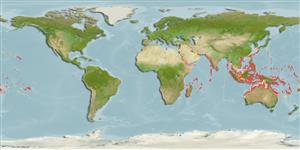Common names from other countries
>
Gobiiformes (Gobies) >
Gobiidae (Gobies) > Gobiinae
Etymology: Amblygobius: Greek, amblys = darkness + Latin gobius = gudgeon (Ref. 45335).
More on author: Herre.
Environment: milieu / climate zone / depth range / distribution range
Ecologia
marinhas associadas(os) a recifes; intervalo de profundidade 1 - 30 m (Ref. 86942). Tropical; 35°N - 28°S, 32°E - 143°W
Western Indian Ocean: Maldives (Ref. 30829) and the Red Sea and Arabian Gulf (Ref. 11441). Pacific Ocean: Philippines to the Tuamoto Islands, north to Yaeyama Islands, south to Rowley Shoals, southern Great Barrier Reef and Rapa; Guam and Kapingamarangi in Micronesia.
Tamanho / Peso / Idade
Maturity: Lm ? range ? - ? cm
Max length : 10.0 cm SL macho/indeterminado; (Ref. 48637)
Descrição breve
Chaves de identificação | Morfologia | Morfometria
Espinhos dorsais (total) : 7; Raios dorsais moles (total) : 13 - 15; Espinhos anais: 1; Raios anais moles: 13 - 15. Characterized by having overall pale grey body color; head and body with pink stripes, most intense on head; dorsal fin base with row of 8-9 dark spots; first and second dorsal fin equal in height; slightly pointed caudal fin; longitudinal scale series 63-66; cycloid scales; head without scales; depth of body 4.7-6.4 in SL (Ref. 90102).
Solitary or in pairs (Ref. 90102). Common in areas with fine sand to muddy bottoms at the bases of inner lagoon and coastal reefs. Monogamous (Ref. 52884, 48637). Feeds on small invertebrates and organic matter (Ref. 89972).
Life cycle and mating behavior
Maturities | Reprodução | Spawnings | Egg(s) | Fecundities | Larvas
Monogamous mating is observed as both obigate and social (Ref. 52884).
Myers, R.F., 1991. Micronesian reef fishes. Second Ed. Coral Graphics, Barrigada, Guam. 298 p. (Ref. 1602)
Categoria na Lista Vermelha da IUCN (Ref. 130435)
CITES (Ref. 128078)
Not Evaluated
Ameaça para o homem
Harmless
Utilização humana
Pescarias: espécies comerciais; Aquário: Espécies comerciais
Ferramentas
Relatórios especiais
Descarregue XML
Fontes da internet
Estimates based on models
Preferred temperature (Ref.
115969): 25.1 - 29.3, mean 28.3 (based on 2853 cells).
Phylogenetic diversity index (Ref.
82804): PD
50 = 0.5000 [Uniqueness, from 0.5 = low to 2.0 = high].
Bayesian length-weight: a=0.01023 (0.00477 - 0.02194), b=3.02 (2.84 - 3.20), in cm Total Length, based on LWR estimates for this (Sub)family-body shape (Ref.
93245).
Nível Trófico (Ref.
69278): 3.0 ±0.2 se; based on size and trophs of closest relatives
Resiliência (Ref.
120179): Elevada, tempo mínimo de duplicação da população menor que 15 meses (Preliminary K or Fecundity.).
Fishing Vulnerability (Ref.
59153): Low vulnerability (10 of 100).
